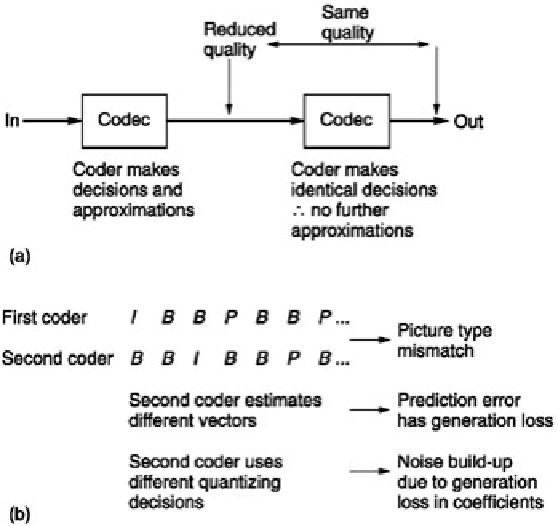Information Technology Reference
In-Depth Information
The most editable form of MPEG is to use
I
data only. As there is no temporal coding, pure cut edits can be made
between pictures. The next best thing is to use a repeating
IB
structure which is locked to the odd/ even field
structure. Cut edits cannot be made as the
B
pictures are bidirectionally coded and need data from both adjacent
I
pictures for decoding. The
B
picture has to be decoded prior to the edit and reencoded after the edit. This will
cause a small concatenation loss.
Beyond the
IB
structure processing gets harder. If a long GOP is used for the best compression factor, an
IBBPBBP . . .
structure results. Editing this is very difficult because the pictures are sent out of order so that
bidirectional decoding can be used. MPEG allows closed GOPs where the last
B
picture is coded wholly from the
previous pictures and does not need the
I
picture in the next GOP. The bitstream can be switched at this point but
only if the GOP structures in the two source video signals are synchronized (makes colour framing seem easy).
Consequently in practice a long GOP bitstream will need to be decoded prior to any production step. Afterwards it
will need to be re-encoded.
This is known as
naive
concatenation and an enormous pitfall awaits. Unless the GOP structure of the output is
identical to and synchronized with the input the results will be disappointing. The worst case is where an
I
picture is
encoded from a picture which was formerly a
B
picture. It is easy enough to lock the GOP structure of a coder to a
single input, but if an edit is made between two inputs, the GOP timings could well be different.
As there are so many structures allowed in MPEG, there will be a need to convert between them. If this has to be
done, it should only be in the direction which increases the GOP length and reduces the bit rate. Going the other
way is inadvisable. The ideal way of converting from, say, the
IB
structure of a news system to the
IBBP
structure
of an emission system is to use a recompressor. This is a kind of standards convertor which will give better results
than a decode followed by an encode.
The DCT part of MPEG itself is lossless. If all the coefficients are preserved intact an inverse transform yields the
same pixel data. Unfortunately this does not yield enough compression for many applications. In practice the
coefficients are made less accurate by removing bits starting at the least significant end and working upwards. This
process is weighted, or made progressively more aggressive as spatial frequency increases.
Small-value coefficients may be truncated to zero and large-value coefficients are most coarsely truncated at high
spatial frequencies where the effect is least visible.
Figure 5.93(a) shows what happens in the ideal case where two
identical
coders are put in tandem and
synchronized. The first coder quantizes the coefficients to finite accuracy and causes a loss on decoding. However,
when the second coder performs the DCT calculation, the coefficients obtained will be identical to the quantized
coefficients in the first coder and so if the second weighting and requantizing step is identical the same truncated
coefficient data will result and there will be no further loss of quality.
[
7
]
Figure 5.93:
(a) Two identical coders in tandem which are synchronized make similar coding decisions and cause
little loss. (b) There are various ways in which concatenated coders can produce non-ideal performance.
In practice this ideal situation is elusive. If the two DCTs become non- identical for any reason, the second
requantizing step will introduce further error in the coefficients and the artifact level goes up. Figure

